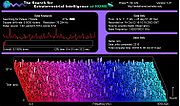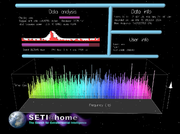- Search for extraterrestrial intelligence
-
Search for Extra-Terrestrial Intelligence
Search for Extra-Terrestrial Intelligence, abrégé par SETI et que l'on peut traduire par « recherche d'une intelligence extraterrestre », est un programme d'origine américaine qui date des années 1960. Il regroupe des projets dont le but est de détecter les signaux qu'une intelligence extraterrestre pourrait émettre, volontairement ou non, depuis sa planète d'origine. Les projets analysent le spectre électromagnétique provenant de l'espace et essaient de détecter les signaux par opposition au bruit aléatoire.
Le programme ne suppose pas forcément que ces extraterrestres essayent de nous contacter. Il essaie de repérer les ondes émises de manière intentionnelle ou non. De même, les ondes électromagnétiques émises de la Terre à chaque instant pourraient être détectées depuis l'espace sans que les humains cherchent pour autant à signaler leur présence.
Depuis le premier projet Ozma de Frank Drake en 1959, on en compte aujourd'hui plus de 70.
Parmi les initiateurs du projet, on peut citer Carl Sagan.
Sommaire
SETI@Home
L'un de ces projets s'appelle SERENDIP. Ayant besoin d'énormes capacités de calcul, l'université de Berkeley a développé un logiciel nommé SETI@home en 1999.
Il consiste à utiliser les processeurs de milliers d'ordinateurs connectés à Internet afin d'analyser ces données. Les calculs sont menés de façon transparente pour l'utilisateur. Les résultats de chaque calcul sont transmis à un serveur central qui se charge également de distribuer les tâches parmi les unités de calcul. Le programme de calcul de SETI@Home cherche par exemple des signaux gaussiens caractéristiques d'un émetteur radio.
SETI@home est le premier projet de calcul réparti grand public. Depuis, il a été adapté pour s'étendre à d'autres projets. Le logiciel s'appelle maintenant BOINC et SETI@home n'est plus considéré que comme un « module » de BOINC.
Des amateurs, comme les radioastronomes amateurs et les radioamateurs, vont même jusqu'à monter chez eux leurs propres radiotélescopes SETI. Ils utilisent pour cela, des récepteurs radios très sensibles, permettant de surveiller la fréquence de l'hydrogène neutre dans les 1 420 MHz (UHF) et de petites paraboles de 3 à 5 mètres de diamètres comme antennes.
Les projets
Voilà quelques projets :
- Allen Telescope Array
- Projet Phoenix
- SERENDIP
- Signal Wow!
- Microwave Observing Program
Notes et références
Liens externes
- (en) Site de l'Institut SETI
- (en) Site de la SETI League
- (fr) Pages françaises de la SETI League
- (fr) L'Alliance francophone
- (fr) Un point de vue concernant le bilan de SETI
- (fr) « Le contact se fait attendre » sur le site Geek mais pas trop
- Portail de l’astronomie
Catégorie : Programme SETI
Wikimedia Foundation. 2010.


